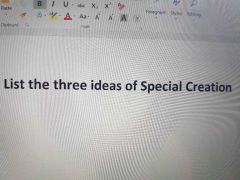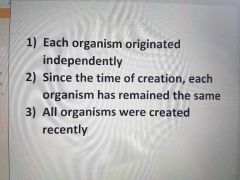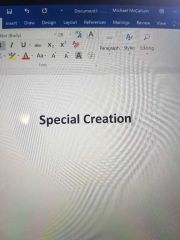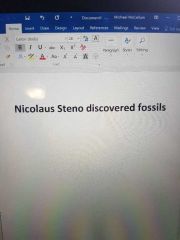![]()
![]()
![]()
Use LEFT and RIGHT arrow keys to navigate between flashcards;
Use UP and DOWN arrow keys to flip the card;
H to show hint;
A reads text to speech;
195 Cards in this Set
- Front
- Back

|

|
|

|

|
|

|

|
|
|
Who is credited with the discovery of fossils? |
Nicolaus Steno |
|
|
In what year did Nicolaus Steno discover fossils he called"tongue stones" |
1666 |
|
|
What is Carolus Linnaeus known for? |
Originating the taxonomic system of naming things |
|
|
Who created the taxonomic system? |
Carolus Linnaeus |
|
|
In what century was taxonomy developed? |
18th century (1700s) |
|
|
What did Georges Buffon suggest in the mid 1700s that was different from other theories of life thus far? |
Species could change when they moved to a new place, first hints at evolution |
|
|
Who, in the mid 1700s, was the first philosopher to suggest species could change? |
Georges Buffon |
|
|
Approximately when did Georges Buffon present his theory of life? |
Mid 1700s |
|
|
In the 1700s, what theories did geologists present that changed how we thought of the earth? |
Rocks form slowly so earth must be old, fossils are different from species seen today so species can go extinct, species appear and disappear, and gradual changes in geology can be explained by processes we see today |
|
|
Jean-Baptiste Lamarck is important because: |
He presented the first detailed theory of evolution, which suggested species change through time |
|
|
The first detailed theory of evolution was presented by whom? |
Jean-Baptiste Lamarck |
|
|
Darwin's two great ideas are: |
Descent with modification, and natural selection |
|
|
Descent with modification and natural selection were ideas of which philosopher? |
Charles Darwin |
|
|
Fitness is a measure of: |
The appropriateness of an individual's attributes for a particular environment. |
|
|
The term used to describe how well an individual is suited for its environment is: |
Fitness |
|
|
Darwin and Wallace presented their findings at the Linnean Society in what year? |
1858 |
|
|
In what year was the origin of species published |
1859 |
|
|
What was Darwin's big knowledge gap? |
Genetics |
|
|
When did Mendel publish his studies on inheritance? |
1865 |
|
|
The theory of modern evolutionary synthesis was developed around what time? |
1930s/40s |
|
|
Modern evolutionary synthesis emphasized what evolutionary mechanisms? |
Random mutation, natural selection, genetic drift, and gene flow |
|
|
The terminal end of a phylogenetic tree are called what? |
Tips |
|
|
Common ancestors and splits in a phylogenetic tree are represented by |
Nodes |
|
|
A lineage evolving through time is represented in a phylogenetic tree by |
Branches |
|
|
A clade is defined as |
An organism and all of its descendants |
|
|
The tips on a phylogenetic tree represent: |
Species, molecules, or populations. Individuals |
|
|
Internal nodes of a phylogenetic tree represent? |
Ancestral species/common ancestors |
|
|
Branches on a phylogenetic tree represent? |
Lineages evolving through time between speciation events |
|
|
An organism and all of its descendants can be grouped into what on a phylogenetic tree? |
A clade |
|
|
Is the structure of a phylogenetic tree fixed? |
No. It can be rotated and reformed provided ancestral species and clades do not get mixed up |
|
|
Is the topology of a phylogenetic tree determined by the number of tips? |
No, depending on scale of interest, an entire clade can be simplified into one branch or tip |
|
|
Can clades be simplified into fewer tips on a phylogenetic tree? |
Yes if we are not interested in studying those species |
|
|
Are there higher or lower organisms? |
No, every species continues to evolve |
|
|
Is there a main line of evolution? |
No, every species is evolving to fit it's habitat and not trying to become some perfect organism |
|
|
Can we make inferences across the tips of a phylogenetic tree? |
No |
|
|
Define outgroup |
A group that is clearly outside of a group whose evolutionary relationships want to be inferred, but clearly related to that group. |
|
|
A species who is closely related to a group of individuals we want to infer the evolutionary history of, but is clearly outside of that group, is called an: |
Outgroup |
|
|
Define phylogenetic tree |
Graphical depictions of the evolutionary history of a group |
|
|
A graphical depiction of the evolutionary history of a group is a what? |
Phylogenetic tree |
|
|
Define synapomorphy |
A shared derived character state |
|
|
A shared derived character trait is called by what term |
Synapomorphy |
|
|
What is the principle of maximum parsimony |
The alternative phylogenetic tree requiring the fewest evolutionary steps is usually the best |
|
|
The term for selecting a phylogenetic tree variant based on the fewest evolutionary steps is termed what? |
The principle of maximum parsimony |
|
|
Define homoplasy |
A character state similarity not due to common descent |
|
|
This term defines a character trait similarity that is not due to common descent |
Homoplasy |
|
|
An evolutionary reversal describes what event |
Reversion from a derived character state to an ancestral state |
|
|
When a species changes back from a derived character state to an ancestral state |
Evolutionary reversal |
|
|
Convergent evolution is the term for what event |
Independent evolution of a similar trait |
|
|
This term describes when two branches of evolution evolve similar traits |
Convergent evolution |
|
|
Polytomy refers to what state of a phylogenetic tree |
When relationships and evolutionary branches are uncertain due to equally parsimonious phylogenetic trees |
|
|
This term describes when the lineage of species is uncertain due to equally parsimonious phylogenetic trees |
Polytomy |
|
|
Monophyletic is defined as |
A group that includes a common ancestor and all of its descendants (clade) |
|
|
A group that includes a common ancestor and all of its descendants is termed |
Monophyletic/a clade |
|
|
Paraphyletic is defined as |
A group containing the most recent common ancestor but not all of its descendants |
|
|
The term to describe a group made of a common ancestor but not all of its descendants |
Paraphyletic |
|
|
Are all Linnean classifications monophyletic? |
No. See reptiles and birds |
|
|
Population genetics is described as |
The study of the the distribution of alleles in populations and causes of frequency changes |
|
|
The study of the distribution of alleles in populations and the causes of allele frequency changes is termed |
Population genetics |
|
|
What is the description for gene? |
A sequence of DNA transcribed into RNA |
|
|
A sequence of DNA transcribed into RNA is termed |
A gene |
|
|
A locus is described as |
A region of DNA. Is not limited to genes, can include non-transcribed regions |
|
|
A region of DNA is termed |
A locus |
|
|
What is the definition of allele? |
A sequence variation at a genetic locus/Mutually exclusive alternative states for a locus. |
|
|
The term used for a sequence variant at a genetic locus or mutually exclusive alternate states for a locus |
Allele |
|
|
Define genotype |
Typically the full set of alleles at a locus or set of loci of interest. Could be the entire genome |
|
|
The term used for the full set of alleles at a locus or set of loci of interest, including the entire genome |
Genotype |
|
|
Changes in the frequency of traits in a population can be traced back to what? |
Changes in the frequency of alleles |
|
|
Evolution from a population genetics perspective is described as: |
Changes in allele frequencies across generations |
|
|
Define Hardy Weinberg equilibrium |
In the absence of evolutionary forces, the allele frequencies of a population will not change |
|
|
The term used to describe the unchanging frequencies of alleles in a population absent of outside evolutionary forces |
Hardy Weinberg equilibrium |
|
|
What are the 5 assumptions required for a Hardy Weinberg equilibrium |
1) the population is infinitely large (no genetic drift) 2) genotypes do not differ in fitness (no natural selection) 3) there is no mutation 4) mating is random (no inbreeding) 5) there is no migration (no gene flow) |
|
|
If the frequency of allele A is p, and the frequency of allele a is q, the genotype frequencies are given by |
AA = p^2 Aa = 2pq aa = q^2 |
|
|
What are the ultimate source of all genetic variation? |
Mutations |
|
|
What is the probability of a mutation occurring per site per cell division in yeast? |
0.00000003% / 3*10^-8% |
|
|
Are all mutations passed on to offspring? |
No, if a mutation does not occur in a germ-lune it will not be passed on |
|
|
What are the seven types of mutations? |
1) Point mutation (changing a single gene to another) 2) insertion (placing a new series of genes into an existing string) 3) deletion (removing a set of genes from the code) 4) gene duplication (adding an extra copy of a gene) 5) inversion (inverting the order of a set of genes) 6) chromosome fusion 7) genome duplication (copying an extra set of the entire genome) |
|
|
How does selection affect allele frequencies? |
Increases the frequency of beneficial alleles and decreases frequency of deleterious alleles |
|
|
Define heterozygous advantage |
When a heterozygous allele provides a better fitness in an environment than either of the homozygous variants |
|
|
When does natural selection occur? |
When genotypes differ in relative fitness |
|
|
What determines the rate of change of an allele's frequency? |
Both the fitness of the allele and it's frequency in the population |
|
|
Rare alleles are almost always in what state? |
Heterozygous |
|
|
Do dominant beneficial alleles go to fixation via selection alone? |
No |
|
|
Fixation is defined as |
A 100% frequency of an allele. Every individual in a population has the allele, and it's impossible to remove from the population once fixed. |
|
|
When an allele's frequency reaches 100% it is said to be |
Fixed or have reached fixation |
|
|
How important is genetic drift for evolution |
Almost as important as natural selection |
|
|
The term used to describe different reproductive success of certain alleles due to chance rather than increased fitness |
Genetic drift |
|
|
Does genetic drift lead to an increase in average fitness for a population? |
No |
|
|
What is the affect of population size on the affects of genetic drift? |
Genetic drift is stronger with a smaller population size |
|
|
How does initial allele frequency affect genetic drift |
A high initial allele frequency is more likely to fix, a low initial allele frequency is more likely to be lost |
|
|
A bottleneck leads to |
A sudden decrease in population size |
|
|
A sudden decrease in population size is termed a |
Bottleneck |
|
|
Founder affects are |
When a new population is started from a small sample of individuals |
|
|
The term used for when a new population is started by a small number of individuals |
Founder effects |
|
|
Are evolutionary mechanisms mutually exclusive? |
No, in a small population genetic drift is stronger than natural selection, in a large population natural selection is stronger than genetic drift, but both forces act on any population at any time |
|
|
What mechanism causes genetic drift |
The random sampling of alleles during formation of gametes in reproduction |
|
|
Inbreeding leads to an increase in the frequency of what kind of allele |
Homozygous recessive |
|
|
Inbreeding depression is defined as what |
The increased frequency of homozygous recessive alleles that reduce fitness |
|
|
The term used for the increased frequency of homozygous recessive alleles due to mating between close relatives |
Inbreeding depression |
|
|
A higher inbreeding coefficient (F) is good or bad? |
Bad |
|
|
The inbreeding coefficient is described as |
The probability that the two alleles at any locus will be identical by descent |
|
|
The term used to describe the probability that the two alleles at any locus are identical by descent |
Inbreeding coefficient (F) |
|
|
When are alleles described as identical by descent? |
When they arose from the same mutational event |
|
|
When alleles arose from the same mutational event they are described as |
Identical by descent |
|
|
Does inbreeding change allele frequencies? |
No but it changes the distribution of alleles among genotypes |
|
|
Is migration enough to affect allele frequencies in a population? |
No, there must be reproduction for gene flow to occur |
|
|
The term used for the change in allele frequencies due to movement of individuals among populations |
Gene flow |
|
|
Gene flow is described as |
The change in allele frequencies due to movement and mating of individuals among populations |
|
|
What does the F(st) value represent? |
The genetic variance between populations due to seperation |
|
|
A higher value of F(st) means that |
The populations are more divided and therefore more genetically distinct |
|
|
Does the amount of gene flow change with the biology of an organism? |
Yes, different species have larger ranges or migrate further. The same distance of seperation between different species applies a different value of F(st) |
|
|
When a population is subdivided into regions, what are the effects on genetic drift? |
Genetic drift is stronger since the effective population size is smaller |
|
|
How does gene flow affect allele frequencies? |
Gene flow counteracts population subdivision by homogenizing allele frequencies |
|
|
Define polygenic |
Influenced by many genetic loci (additive/dominant effects among alleles, interaction between loci, interaction with environment) |
|
|
The term used when a trait is influenced by many genetic loci |
Polygenic |
|
|
Define epistasis |
The interaction between loci |
|
|
Define phenotypic plasticity |
Genetic loci interacting with the environment |
|
|
Define quantitative genetics |
The study of the genetic mechanisms of continuous phenotypic traits |
|
|
What is the simplest way to think about polygenic inheritance |
Can think of each locus as having either a positive or negative effect and the trait value is the sum of all the positives minutes the number of negatives |
|
|
Increasing the number of alleles influencing a trait makes it difficult to estimate genotypes in a phenotype because |
More than one genotype leads to each phenotype, and increasing the number of alleles responsible for the trait means one phenotype can have many different genotypes responsible |
|
|
A quantitative trait has three prerequisites, what are they? |
1) influenced by many loci, each with a small effect 2) experience both genetic and environmental variation 3) can't easily determine genotype by phenotype |
|
|
How many genes affect quantitative traits? |
Studies suggest often 20-30 loci per trait |
|
|
Does every loci have a small effect on a trait? |
No, sometimes many genes have small effects while a few genes have large effects. |
|
|
The phenotypic variance is described as |
The sum of the genetic variance and the environmental variance |
|
|
Genotypic variance can be broken down into which parts? |
1) additive (Va) - summed effects of all loci 2) dominance (Vd) - interactions between alleles within a locus 3) epistatic (Vi) - interactions among loci |
|
|
Of the three subdivisions of genetic variance, which are we most concerned with (for this course)? |
Additive variance |
|
|
What are the two subdivisions of environmental variance? |
1) among individuals (Ve) 2) among families (Vm) - maternal affects |
|
|
Broad-sense heritability is described as |
The proportion of total phenotypic variation that is due to genetic variation (division of total variance by the genetic variance) |
|
|
Narrow sense heritability is described as |
The proportion of total phenotypic variation that's caused by additive genetic variation (additive genetic variation ÷ total phenotypic variation) |
|
|
What does narrow sense heritability predict? |
The response to natural selection |
|
|
Heritability refers to |
The relative importance of genetics to differences among individuals in a population |
|
|
Does heritability say anything about the differences between populations? |
No |
|
|
Does a large heritability stop environmental changes from having a large effect? |
No |
|
|
What are the heritability estimates specific to? |
The environment in which they are measured. Phenotype represents the effects of genes acting within an environment |
|
|
What are three potential problems for parent-offspring regression? |
1)Misidentifying parents 2) environmental correlation between parents and offspring 3) maternal effects |
|
|
How do the heritabilities of life history, behavior, and morphology compare? |
Life history has a smaller heritability value than behavior which has a smaller heritability than morphology |
|
|
Can evolution be measured in the wild? |
Yes |
|
|
What is fitness measured relative to? |
The rest of the population |
|
|
Selection can be three things: |
Directional, stabilising, or disruptive |
|
|
What is the strength of selection in the wild |
Usually weak but can be very strong |
|
|
Just because selection is strong, will there be an evolutionary response? |
Not always |
|
|
If a trait is heritable, will there be a response to a selection event? |
Yes |
|
|
If a trait is not heritable, will there be a response to natural selection? |
No |
|
|
What is breeders equation? |
R = h^2S (evolutionary response to selection is equal to heritability multiplied by the selection differential) |
|
|
What is the equation for selection differential? |
S = mean(after) - mean(before). The selection differential is simply the difference in average values of a trait before and after selection |
|
|
Describe directional selection |
When a smaller or larger average value for a trait is favored, the average value after selection moves in the positive or negative direction |
|
|
When selection selects for either a larger or smaller average value and the average value for that trait shifts in the positive or negative direction, which type of selection is it? |
Directional selection |
|
|
Describe stabilizing selection |
When intermediate values of a trait are favored. When the average value of a trait stays the same but selection removes values at the extremes of the distribution, decreasing the variance and making the distribution thinner. |
|
|
When selection favors intermediate values and removes individuals with traits at the extreme ranges from the average value, what type of selection is it? |
Stabilizing selection |
|
|
Describe disruptive selection |
When extreme values of a trait are favored, and intermediate values of the trait are removed, causing a split distribution |
|
|
When extreme values of a trait are favored and selection removes intermediate traits from the population, what type of selection is it? |
Disruptive selection |
|
|
Can we use the selection differential to measure reproductive success? |
No. We must use a selection gradient |
|
|
When we graph the relationship between a trait and relative fitness, what does the slope represent? |
The selection gradient |
|
|
Describe selection gradient |
The slope of the effect of a trait on relative fitness |
|
|
Can natural selection be measured in the wild? |
Yes |
|
|
What is fitness measured relative to? |
The rest of the population |
|
|
What are the three types of selection? |
Directional, stabilizing, and disruptive selection |
|
|
Is selection in the wild typically weak or strong? Is it possible for selection to be the other value (strong or weak)? |
Typically weak, can be very strong |
|
|
Are evolution and selection the same thing? |
No. Selection is how well a trait affects survival/reproduction, and evolution is a change of trait frequency in response to selection. Evolution depends on heritability. |
|
|
Describe phenotypic plasticity |
The capacity of a single genotype to produce different phenotypes depending on the environment |
|
|
The capacity of a single genotype to produce different phenotypes depending on the environment is called: |
Phenotypic plasticity |
|
|
For a trait to be possible to evolve, what basis does it need to have? |
A genetic basis |
|
|
Does phenotypic plasticity respond faster or slower than evolution? |
Phenotypic plasticity responds much faster than evolution, and is good for constantly changing habitats |
|
|
Quantitative genetics is the study of what? |
The study of the inheritance of continuously varying traits |
|
|
What is the term for the study of the inheritance of continuously varying traits? |
Quantitative genetics |
|
|
Ernst Haeckel's biogenetic law states that: |
Organisms pass through the adult stages of their ancestors during their development |
|
|
The CIS regulation of genes regulated which part of gene expression? |
The CIS regulation of genes regulate the specific timing during development and gene expression |
|
|
Do homeobox genes have a large influence in animal morphology? |
Even though homeobox genes contain a highly conserved region of 180 base pairs, they have a major influence on animal morphology |
|
|
The order of genes in the homeobox region correlates to the order of what in the species? |
The order of homeobox genes is the same as the order of traits on the animal from anterior to posterior |
|
|
Can new traits arise from existing genes being expressed in a different developmental context? |
Yes |
|
|
Which genes can be modified rapidly and cause extraordinary diversity in closely related species? |
The homeobox (hox) genes |
|
|
Define anisogamy |
Gametes of a species are very different in size (sperm being much smaller than eggs typically) |
|
|
Define isogamy |
Gametes being the same size |
|
|
What are the limits of reproductive success between males and females? |
Females are limited by their fecundity (# of eggs produced), males are limited by their number of mates |
|
|
What is the major detrimental cost of sex? |
Only half the population can produce offspring |
|
|
What are the benefits of sex |
Sex results in more genetic variation, causing faster evolution. |
|
|
How does sex affect the parasites of a specific organism |
Sexual reproduction creates more genetic variation, allowing for faster evolution, which allows a species to develop resistances to parasites (the red queen effect) |
|
|
Define the red queen effect: |
Sexual reproduction allows an organism to compete in a biological arms race against its parasites |
|
|
Describe Muller's Ratchet |
The accumulation of deleterious alleles through asexual reproduction |
|
|
Which environment favors asexual reproduction and which environment favors sexual reproduction? |
A stable and unchanging environment favors asexual reproduction, a changing environment favors sexual reproduction |
|
|
Define sexual selection |
The selection on a specific sex of a species for reproduction involving traits that do not contribute to environmental fitness. |
|
|
Define the operational sex ratio |
The ratio of males capable of reproducing to females capable of reproducing |
|
|
Which sex is typically biased in the operational sex ratio |
Females being pregnant and lactating for long periods of time typically results in a male biased operational sex ratio |
|
|
Define intrasexual selection |
When males compete with males (or females compete with females) |
|
|
Define intersexual selection |
When females choose the males or when males choose the females |
|
|
What are some examples of post-copulation competition? |
Mate guarding, mate guarding by groups, vagina plugs, sperm removal, sperm production, faster sperm, semen being toxic to other males' sperm |
|
|
What are three ways to identify species |
Morphological species concept, biological species concept, and phylogenetic species concept |
|
|
Describe the morphological species concept |
Smallest groups derived from a common ancestor with a morphological gap between them |
|
|
Define biological species concept |
Groups of interbreeding populations that are reproductively isolated from other groups |
|
|
Define phylogenetic species concept |
Smallest possible group descending from a common ancestor and defined by synapomorphies |
|
|
Define allopatric speciation |
Different places. Through either vicariance (geological barrier) or the founder effect |
|
|
Define parapatric speciation |
Populations are connected |
|
|
Define sympatric speciation |
Species evolved in the same place |

